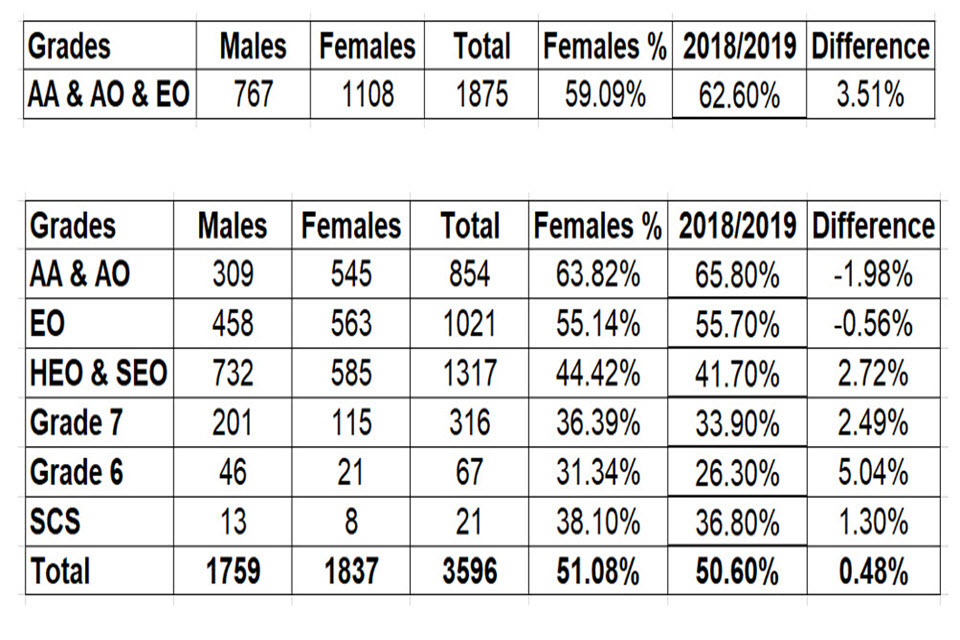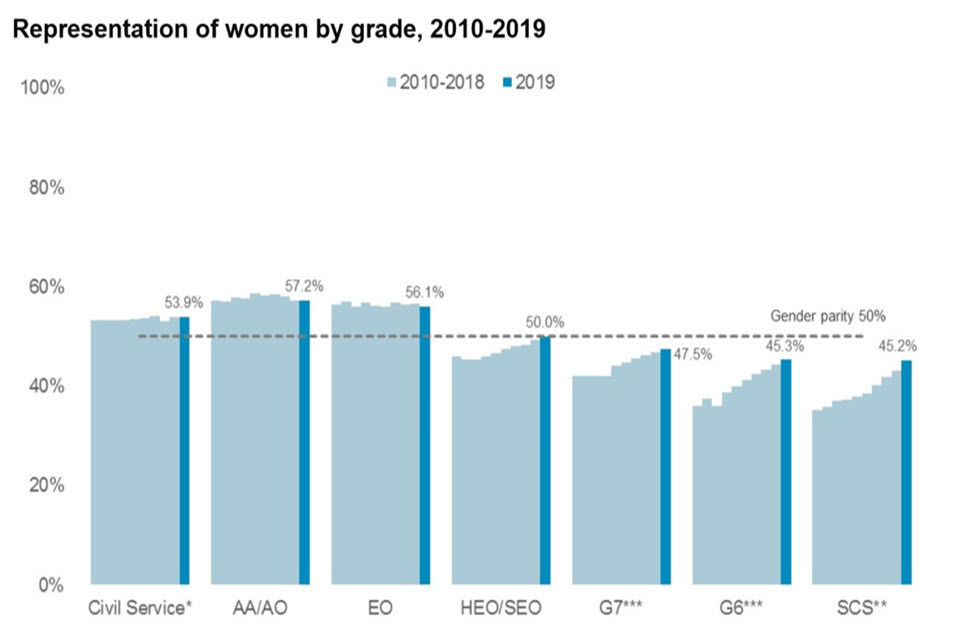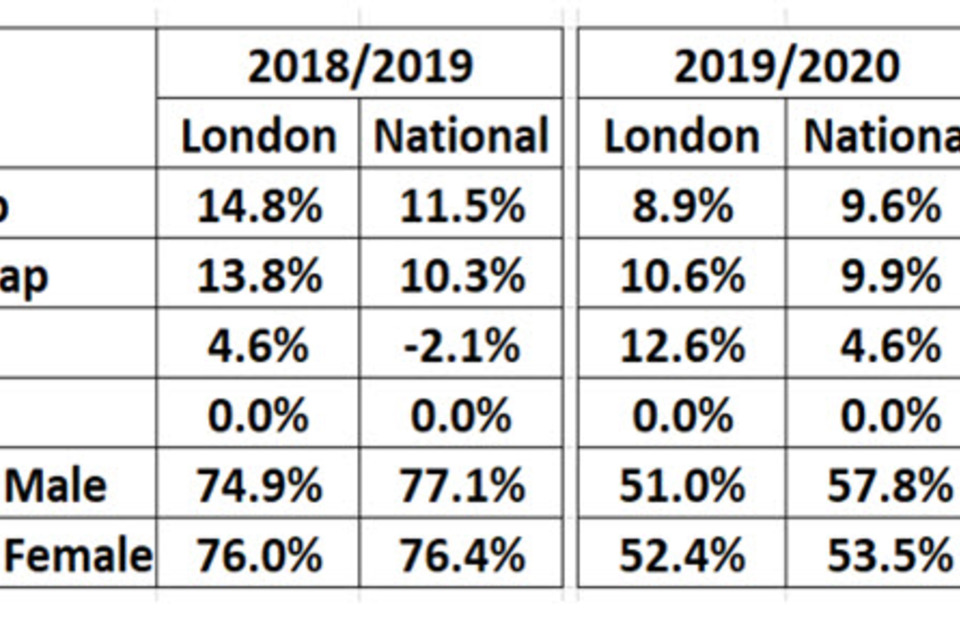VOA's gender pay gap report 2020
Published 15 December 2020
1. Introduction
I am pleased to publish our 2020 gender pay gap report. Pay transparency helps us to understand where our actions to address gender-based pay differences are having an impact, to identify emerging issues and, importantly, to recognise the positive aspects of our employee offer which help to support equality, diversity and inclusion in the Agency.
This is the fourth year we have published our gender pay results, setting out our progress in reducing our gender pay gap – the difference in salary between all the men and women in our workforce.
While we are pleased to report a 2.6% reduction in our overall mean gender pay gap and 7.3% in our overall median gender pay gap since last year (and 4.8% and 9.7% respectively since we published our first report in 2017), there is still work to be done. However we continue to make good progress: the data shows we are closing our overall pay gap, a gap that remains lower than the national average.
The key mean and median gender pay gaps for 2020 are listed below:
- mean gender pay gap is 10.0%
- median gender pay gap is 6.6%
- mean bonus gap is now 6.1%
- median bonus gap is 0.0%
The underlying reason for our overall gender pay gap remain the same as in previous years: we have a greater proportion of men than women at senior levels. This is improving year by year but it is evident in the pay gaps when analysed by grade.
The flexible working arrangements we have in place support people’s work-life balance and the various talent and development programmes that are open to colleagues at all grades continue to form part of our response to addressing our gender pay differences.
We are committed to increasing our understanding of why we have any gender pay gaps and taking action to close them. This report help us to identify areas we need still to focus on. We continue to work closely with our colleagues and Trade Unions as key partners to tackle the issues identified and to champion equality, diversity and inclusion for everyone in the Agency.
Jonathan Russell CB Interim CEO and Chief People Officer, Valuation Office Agency
2. Overview
In 2017, the Government introduced world-leading legislation that made it statutory for organisations with 250 or more employees to report annually on their gender pay gap. Government departments are covered by the Equality Act 2010 (Specific Duties and Public Authorities) Regulations 2017 which came into force on 31 March 2017. These regulations underpin the Public Sector Equality Duty and require relevant organisations to publish their gender pay gap by 30 March annually. This includes the mean and median gender pay gaps; the mean and median gender bonus gaps; the proportion of men and women who received bonuses; and the proportions of male and female employees in each pay quartile.
The gender pay gap shows the difference in the average pay between all men and women in a workforce. If a workforce has a particularly high gender pay gap, this can indicate there may be a number of issues to deal with, with lower level calculations helping identify what those issues are.
The gender pay gap is different to equal pay. Equal pay deals with the pay differences between men and women who carry out the same jobs, similar jobs or work of equal value. It is unlawful to pay people differently because they are a man or a woman.
Building a diverse and inclusive workforce that reflects the people we serve is one of the Civil Service’s top workforce priorities. Our collective aim is to make the Civil Service the UK’s most inclusive employer. Our Diversity and Inclusion Strategy outlines how we plan to achieve this. The Civil Service should create opportunities for all in a truly meritocratic way and reward all civil servants fairly, regardless of gender, ethnicity or any other personal characteristic.
The VOA supports the fair treatment and reward of all staff irrespective of gender.
3. VOA Gender Pay Gap report 2020
This report gives the gender pay gap data in the VOA as at 31 March 2020.
Our Gender Pay Gap for 2020 is:
- Mean gender pay gap is 10.0% - a reduction from 12.6% in 2019
- Median gender pay gap is 6.6% - a reduction from 14.0% in 2019
- Mean bonus gap is now 6.1% - having previously been -0.9% in 2019
- Median bonus gap is 0.0% - unchanged since 2019
For salaries we used a snapshot date of 31 March 2020. The relevant pay period was our March payroll.
For bonuses we used the period 1 April 2019 to 31 March 2020: the 12 months before the snapshot date.
The Gender Pay Gap data supplied is correct for all staff in post and on the VOA payroll on 31 March 2020. The results are below at Annex A.
In the VOA, on the 31 March 2020 there were 3,596 staff in post, a small increase of 21 from last year.
Our gender balance was:
- Women: 1,837 (51.08%) an increase of 27 women from last year
- Men: 1,759 (48.92%) a decrease of 6 men from last year
The VOA follows the standard public sector approach to pay and grading. All posts sit within one of ten levels (grades), and each level has an associated pay range consisting of a minimum and maximum rate. The AA grade consists of a single spot rate. Salaries are paid according to grade and annual pay awards within the grade are paid irrespective of gender. At the date of this report there remain 80 employees who opted to remain on legacy pay bands from previous grading arrangements that applied until July 2013.
Our headquarters are in East London, and we have offices right across the UK. All grades, with the exception of those at SCS2 and SCS3 level within the Senior Civil Service (SCS), have both a London and National pay range. At 31 March 2020, we also have one further local pay zone, the Intermediate Zone. This pay zone has since been phased out and was incorporated into the National Pay Zone at 1 August 2020. This report covers the main pay ranges. Those in the Intermediate Zone have been recorded within the National pay range to ensure anonymity, due to the relatively low numbers of employees involved.
For pay purposes we are governed by public sector pay policy, which HM Treasury has overall responsibility for. This defines the overall parameters for civil service pay uplifts each year in the pay guidance, to ensure that civil service pay awards are consistent with the government’s overall objectives.
Our 2019 pay award comprised a consolidated award paid to all staff, subject to performance, together with a non-consolidated underpin payment.
- For staff in delegated grades, bonus payments are made in the form of in-year cash bonuses to recognise commendable performance
- For members of the SCS there is also a non-consolidated award linked to exceptional performance against objectives
The value of both consolidated and non-consolidated pay awards are negotiated with our recognised trade unions, and is subject to HM Treasury and Ministerial business case approval. We do not negotiate individual awards, and our pay system takes no account of gender or any other protected characteristic.
4. Gender Pay Gap data - Base Pay
Our Gender Pay Gap data for 2020 is:
- The mean hourly rate for women is £14.43
- The mean hourly rate for men is £16.04
- The overall mean hourly rate is £15.22
- The mean gender pay gap is 10.0%, a reduction from 12.6% in 2019
- The median hourly rate for women is £12.93
- The median hourly rate for men is £13.85
- The overall median hourly rate is £13.42
- The mean gender pay gap is 6.6 %, a reduction from 14.0% in 2019
The distribution of our workforce drives our mean and median figures: whilst we have a very diverse workforce we do still have a higher proportion of our female workforce in the lower pay grades. The gender mix of our Executive Committee on 31 March 2020 was four men and five women (including two women job sharing one Executive Committee post).
We analysed our gender pay gap results in more depth and found the pattern of gender pay difference is markedly different when considered by geographical area (National and London pay areas - Annex C) and by each individual grade (Annex D).
Our recruitment and promotion policies are based on fair and open competition.
We are committed to offering roles on flexible working patterns, including a range of options such as part-time working, alternative working hours, and enhanced shared parental leave. This includes job share up to and including posts at Senior Civil Servant level.
5. Bonus (Non-consolidated) payments
Our mean bonus gap is now 6.1%.
The 2019/2020 performance year represents the fourth year of our fully in-year cash bonus scheme. As part of a multi-year, flexible case pay deal commencing in August 2019, we converted a proportion of the bonus pay pot into consolidated pay. This allowed us to maximise progression and address recruitment and retention issues. Positive results can be seen in the mean and median base pay in this year’s figures. During this transitional year for our bonus award scheme, there has been a temporary worsening of the mean gender bonus pay gap. To address this issue, and as part of our pay reform programme, we have now abolished this bonus award scheme from September 2020 and replaced it with a scheme based on smaller value awards using vouchers. We will continue to monitor the gender impact of this new scheme.
6. Actions
VOA supports the fair treatment and reward of all staff irrespective of gender. We have pay and conditions of employment that do not discriminate unlawfully and are free from bias by ensuring that equal pay is in place for like-for-like work, work rated as equivalent and work of equal value. We use a job evaluation system to assess the relative value of jobs across the organisation, and this provides evidence in support of the allocation of jobs within our grading structure.
6.1 Recruitment
Civil Service Resourcing have direct responsibility for recruiting all VOA employees. The aim of the vacancy filling is to find the best available people for our jobs, applying the fundamental principle of selection for appointment on merit, through fair and open competition.
6.2 Talent and development programmes
We recognise that our staff don’t all want the same things from their careers. We aim to provide everyone with opportunities to be the best they can be and to progress, whether to more senior roles, or other roles in the Agency or the civil service. To support this, we will continue to encourage staff to benefit from the variety of programmes we have across the department such as Future Leaders Scheme, Leap, Embrace, Ascend and Fast Stream. We have also promoted surveying as a career for women, working with RICS and the Deputy Head of Profession to increase the percentage of women in surveying roles.
6.3 Flexible working
As part of our Transformation programme, we will continue to support staff who wish to work more flexibly, across all grades. Most roles are available as job-share, reduced hours, or flexible working patterns.
6.4 Bonus (Non-consolidated) payments
Until September 2020 we ran a bonus award scheme based on two levels of awards. This scheme was monitored including having an assurance panel that analysed the distribution of non-consolidated payments in year to address issues identified. From November 2020 we will be implementing a new voucher based system.
6.5 Equal Pay Audit
We published our most recent equal pay audit earlier this year. The audit compared pay across multiple protected characteristics, within roles of the same grade and found no significant pay differences. The next Equal Pay Audit will be in 2021.
6.6 Diversity Group
Our Gender Diversity Group supports colleagues and drives action across the Agency. They have been instrumental in creating guidance which supports women and they link into wider civil service work which seeks to understand the challenges women may face in order to provide appropriate support. This includes raising awareness with managers and colleagues about the impact that the menopause can have for women in the workplace; and working with HR policy lead on ensuring that special leave and workplace adjustments policies support women in the workplace.
6.7 Wellbeing
Raising awareness of work-life balance and caring responsibilities, regardless of gender identity. We want to foster an environment where we can talk openly about health concerns, providing support to our colleagues and managers.
7. Calculations
Our calculations followed the legislative requirements, and we confirm the data reported is accurate. All staff who were deemed to be full paid relevant employees (as defined by the Gender Pay Gap reporting provisions) were included.
8. Annex A - Workforce demographics 2020
Women have a disproportionately higher representation in more junior grades AA to EO, where 59.09% are women. This is a decrease of 3.51% from last year.
In more senior grades men have a disproportionately higher representation but this is decreasing over time as more women succeed in gaining positions in senior grades. This year has seen increases in female representation at both Grade 6 and 7 level.
8.1 VOA Data

Pay Gap report table 1
8.2 Civil Service Data

Pay Gap report table 2
Overall, 53.9% of the Civil Service are women in 2019. Current figures have yet to be published. While the over representation of women at grades EO and below has remained largely static over time, there is a distinct increase in the representation of women at HEO and above over time. The VOA matches these general trends.
9. Annex B- 2020 VOA overall Gender Pay Gap results

Pay Gap report table 3
9.1 Note:
- Bonus proportions are expressed as the % of total men/women receiving a bonus that year
- Where pay gap figures are shown, a positive figure denotes the % amount that women’s mean or median hourly salary is lower than men.
- A negative figure denotes instances where the mean or median hourly salary for women is higher than for men.
- The ideal position is therefore 0.00%.
10. Annex C- 2020 Gender Pay Gap results by location

Pay Gap report table 4
10.1 Note:
- Bonus proportions are expressed as the % of total men/women receiving a bonus that year
- Where pay gap figures are shown, a positive figure denotes the % amount that women’s mean or median hourly salary is lower than men.
- A negative figure denotes instances where the mean or median hourly salary for women is higher than for men.
- The ideal position is therefore 0.00%.
11. Annex D- 2020 VOA Gender Pay Gap results by grade

Pay Gap report table 5
Note:
The results for AA/AO are affected by the presence of legacy pay bands in these grades and this may distort the pay gaps shown.
